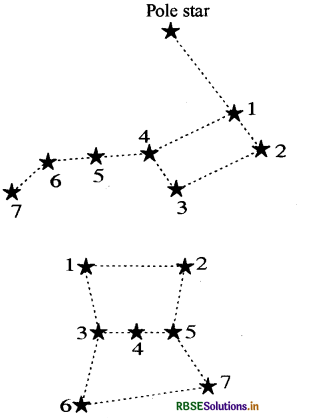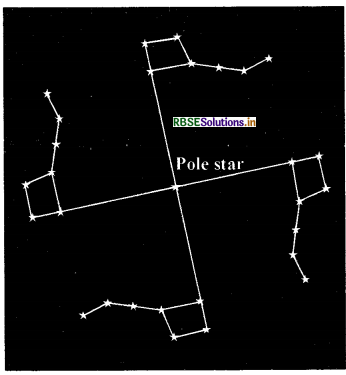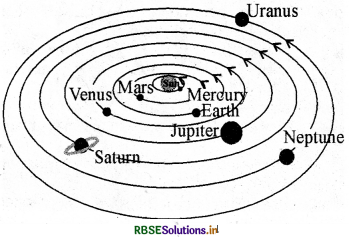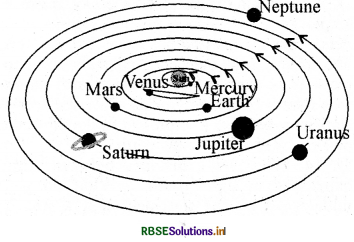RBSE Solutions for Class 8 Science Chapter 17 Stars and The Solar System
Rajasthan Board RBSE Solutions for Class 8 Science Chapter 17 Stars and The Solar System Textbook Exercise Questions and Answers.
Rajasthan Board RBSE Solutions for Class 8 Science in Hindi Medium & English Medium are part of RBSE Solutions for Class 8. Students can also read RBSE Class 8 Science Important Questions for exam preparation. Students can also go through RBSE Class 8 Science Notes to understand and remember the concepts easily. Browsing through class 8 science chapter 14 extra questions that includes all questions presented in the textbook.
RBSE Class 8 Science Solutions Chapter 17 Stars and The Solar System
RBSE Class 8 Science Stars and The Solar System InText Questions and Answers
Page 216
Question 1.
Why does the moon change its shape every day?
Answer:
Moon does not have light of its own. We see only that part of moon, on which the falling sunlight is reflected towards us. Other than this, earth along with moon revolves round the sun. Therefore, in various situations, various phases of moon are seen.

Page 218
Question 2.
I, have heard that we never see the back side of the moon from the Earth. Is it true?
Answer:
Yes, it is true. We never see the back side of the moon from the earth.
Page 219
Question 3.
Can we hear any sound on the moon?
Answer:
No, we cannot hear any sound on the moon because sound needs a medium to trave which is not present on the moon.

Page 220
Question 4.
If light from stars takes years to reach us, I wonder if we are looking into the past we look at stars.
Answer:
Yes, the light that reaches us from the stars is of the past.
Question 5.
I want to know why we do not see the stars during the day. Why are they visible only at night?
Answer:
Stars are present in the sky in the day too, but due to strong light of the sun, we're unable to see them in the light. As the sun hides, we can see the stars.

Page 221
Question 6.
My grandfather told me that there is one star in the sky which does not move at all. How is it possible?
Answer:
The pole star in the sky remains at a fixed position in the sky. Pole star is situated on the axis of rotation of earth and therefore it does not show any movement.
Page 226
Question 7.
I wonder why the planets do not collide while revolving round the Sun.
Answer:
Because each planet has its own assigned path (own orbit) in which it revolves round the earth. Due to this, they do not collide with each other.

Page 227
Question 8.
The Earth revolves round the Sun. Does it make Earth a satellite of the Sun?
Answer:
Yes, earth can be called the satellite of the sun. But generally we call it the planet of earth. Bodies revolving round planets are called satellites.
Page 228
Question 9.
Does it mean that on Venus the Sun would rise in the west and set in the east?
Answer:
Venus rotates from west to east on its axis. Therefore, sunrise is from west and sunset is in east on venus.

Question 10.
If I am 13 years old, how many times have I gone round the sun?
Answer:
Earth completes one revolution of sun in 1 year. This way, in 13 years, I’ve revolved 13 times around sun.
RBSE Class 8 Science Stars and The Solar System Textbook Questions and Answers
Choose the correct answer in Questions 1-3 :
Question 1.
Which of the following is NOT a member of the solar system?
(a) An asteroid
(b) A satellite
(c) A constellation
(d) A comet
Answer:
(c) A constellation

Question 2.
Which of the following is NOT a planet of the sun?
(a) Sirius
(b) Mercury
(c) Saturn
(d) Earth
Answer:
(a) Sirius
Question 3.
Phases of the moon occur because
(a) we can see only that part of the moon which reflects light towards us.
(b) our distance from the moon keeps changing.
(c) the shadow of the Earth covers only a part of moon’s surface.
(d) the thickness of the moon’s atmosphere is not constant.
Answer:
(a) we can see only that part of the moon which reflects light towards us.

Question 4.
Fill in the blanks:
(a) The planet which is farthest from the Sun is .....................
(b) The planet which appears reddish in colour is .....................
(c) A group of stars that appear to form a pattern in die sky is known as a .....................
(d) A celestial body that revolves round a planet is known as .....................
(e) Shooting stars are actually not .....................
(f) Asteroids are found between the orbits of ..................... and .....................
Answer:
(a) Neptune
(b) Mars (Mangal)
(c) constellation
(d) Satellite
(e) Star
(f) Mars, Jupiter
Question 5.
Mark the following statements as true (T) or false (F):
(a) Pole Star is a member of the solar system.
(b) Mercury is the smallest planet of the solar system.
(c) Uranus is the farthest planet in the solar system.
(d) INSAT is an artificial satellite.
(e) There are nine planets in the solar system.
(f) Constellation Orion can be seen only with a telescope.
Answer:
(a) F
(b) T
(c) F
(d) T
(e) F
(f) F

Question 6.
Match items in column A with one or more items in column B:
|
Colum A |
Colum B |
|
(i) Inner planets |
(a) Saturn |
|
(ii) Inner planets |
(b) Pole Star |
|
(iii) Constellation |
(c) Great Bear |
|
(iv) Satellite of the Earth |
(d) Moon |
|
|
(e) Earth |
|
|
(f) Orion |
|
|
(g) Mars |
Answer:
|
Colum A |
Colum B |
|
(i) Inner planets |
(e) Earth (g) Mars |
|
(ii) Inner planets |
(a) Saturn |
|
(iii) Constellation |
(c) Great Bear (f) Orion |
|
(iv) Satellite of the Earth |
(d) Moon |
Question 7.
In which part of the sky can you find Venus if it is visible as an evening star?
Answer:
Western part

Question 8.
Name the largest planet of the solar system.
Answer:
Jupiter
Question 9.
What is a constellation ? Name any two constellations.
Answer:
The stars forming a group that have a recognisable shape is called a constellation. Names of two constellation:
- Great Bear
- Orion.
'
Question 10.
Draw sketches to show the relative positions of prominent stars in
(a) Ursa Major and
(b) Orion
Answer:

Question 11.
Name two objects other than planets which are members of the solar system.
Answer:
- An asteroid
- A comet

Question 12.
Explain how you can locate the Pole Star with the help of Ursa Major.
Answer:
In the sky, Ursa Major seems to rotate about a fixed point. This point is a star called pole star. This pole star seems stationary as it is present on axis of rotation of earth, other stars seem to move about the pole star. The following picture shows different arrangement of Ursa Major after about two to three hours. Pole star is fixed.

Question 13.
Do all the stars in the sky move ? Explain.
Answer:
No, all stars do not move, but it seems like this. Except pole star, all stars seem to move from east to west because earth on its axis rotates from west to east. Pole star seems stationary because it is present in the direction of axis of rotation of the earth.
Question 14.
Why is the distance between stars expressed in light years ? What do you understand by the statement that a star is eight light years away from the Earth?
Answer:
There is a large distance between the stars. This distance is more than even a million or billion kilometer. Therefore, it is difficult to express it in km, and thus, a bigger scale ‘light year’ is used. This statement means that light with its speed
of 3 lakh km/s will reach that star in 8 years.

Question 15.
The radius of Jupiter is 11 times the radius of the Earth. Calculate the ratio of the volumes of Jupiter and the Earth. How many Earths can Jupiter accommodate?
Answer:
Let the radius of earth = r m
∴ radius of Jupiter = 11 r m
volume of earth : volume of Jupiter
= \(\frac{4}{3} \pi r^{3}: \frac{4}{3} \pi(11 r)^{3}\)
= r3 : 1331 r3
= 1 : 1331
so we can say Jupiter can occupie 1331 earths.
Question 16.
Boojho made the following sketch of the solar system. Is the sketch correct? If not, correct it.

Answer:
This sketch is not correct. The corrected sketch is given below:


- RBSE Class 8 Science Notes in Hindi & English Medium Pdf Download
- RBSE Class 8 Science Important Questions in Hindi Medium & English Medium
- RBSE Solutions for Class 8 Science in Hindi Medium & English Medium
- RBSE Class 8 Science Important Questions Chapter 14 Chemical Effects of Electric Current
- RBSE Class 8 Science Notes Chapter 16 Light
- RBSE Class 8 Science Notes Chapter 1 Crop Production and Management
- RBSE Class 8 Science Notes Chapter 2 Microorganisms: Friend and Foe
- RBSE Class 8 Science Notes Chapter 3 Synthetic Fibres and Plastics
- RBSE Class 8 Science Notes Chapter 4 Materials: Metals and Non-Metals
- RBSE Class 8 Science Notes Chapter 5 Coal and Petroleum
- RBSE Class 8 Science Notes Chapter 6 Combustion and Flame